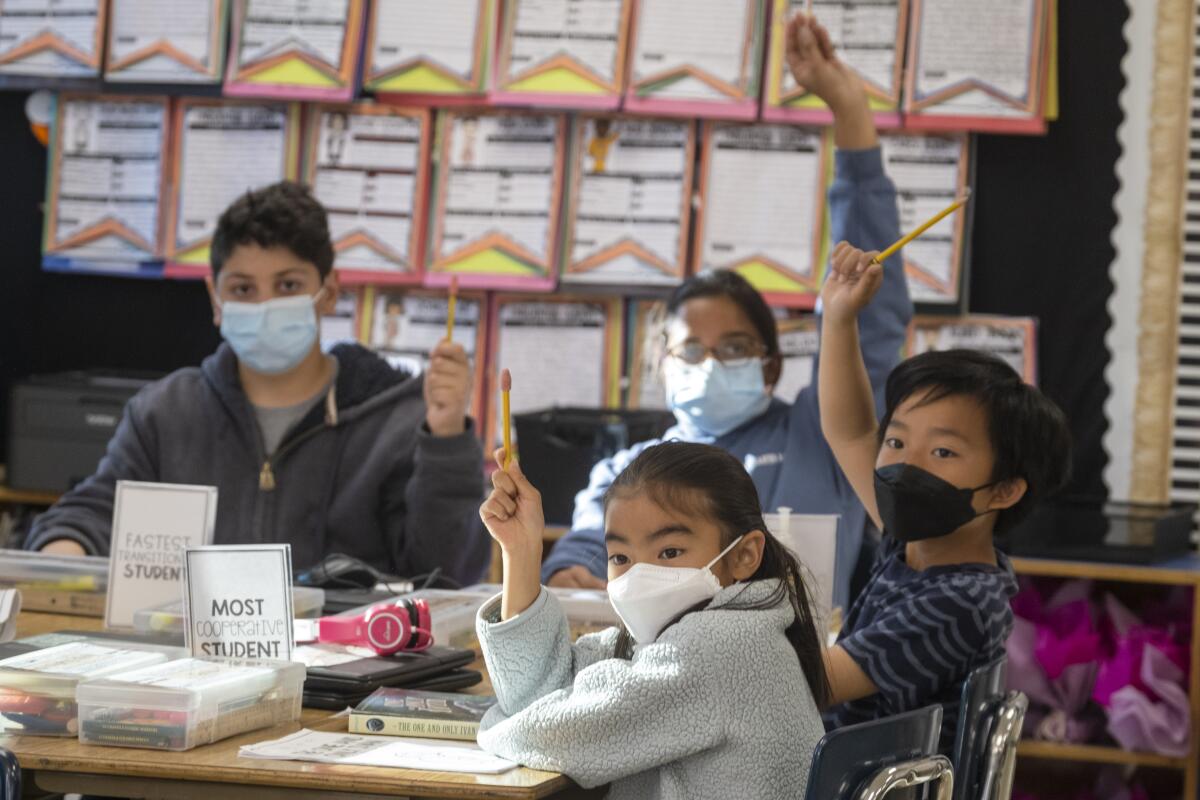How to find out if your childâs classes have teachers with proper credentials. Many donât

SACRAMENTO â At least 10% of Californiaâs public school classrooms are overseen by teachers who are not properly credentialed, according to a first-of-its-kind report released by the Department of Education on Thursday.
The new data shed light on the number of classrooms with instructors who are fully trained in the subject they are assigned to teach. It also shows how many classrooms are led by teachers who are working while awaiting full credentialing. The data come as California schools have been grappling with widespread staffing shortages, a problem compounded by the pandemic.
A vast majority â 83% percent â of classes are led by teachers fully authorized to cover the subjects they teach. Data are unknown for nearly 7% of classrooms. But the report did delve into classrooms without properly trained instructors:
- The 10% of classrooms without credentialed teachers represents 27,500 courses.
- 4.1% of the stateâs teaching assignments are considered âineffective,â meaning educators are using emergency permits or are otherwise teaching without proper authorization.
- 4.4% of classrooms are led by teachers who have a credential but have ânot demonstrated subject matter competenceâ in the course they are assigned to.
- 1.5% of courses are taught by teachers with an intern credential.
The inaugural report was mandated by legislation signed by Gov. Gavin Newsom in 2019 amid concerns about a lack of monitoring and accountability of âteacher misassignments.â
The new data, available on the California Department of Education website, allow the public to drill down to individual districts, schools and grade levels. But advocacy groups, including the Education Trust-West, are pushing the state to provide even more information about how the data impact students of color and those living in poverty as well.
âWe canât fix what we canât see clearly. Thatâs why the release of this data is a vital first step toward better understanding the quality of Californiaâs teacher workforce,â Jana Luft, senior associate for the Education TrustâWest, said Thursday. âNow that we are finally starting to see clearly the equity gaps in teacher preparedness, itâs time to get to work fixing them.â
The stateâs previous, more limited monitoring of credentials showed that such misassignments were disproportionately higher for courses such as special education and in schools located in low income ZIP Codes.
Assemblymember Reggie Jones Sawyer (D-Los Angeles), who authored the bill that requires the state to provide the annual reports on teacher credentials and class assignments, said Thursdayâs results show why it was needed.
âThis is the exact purpose of the legislation â to identify deficiencies in the system and make targeted investments in schools and communities most in need of resources to address these problems,â Jones Sawyer said. âOur main concern is whether or not students are being served and educated properly, especially in Black and Latino communities.â
In school districts like Montebello Unified, where 95% of students are Latino and 74% qualify for free or reduced price meals, less than half of classrooms are led by teachers properly credentialed.
Los Angeles Unified, the largest district in California, is about on par with the state, with 82% of classrooms overseen by teacher properly credentialed. Many of Los Angeles Unifiedâs highest-needs campuses remain significantly understaffed, and the problem has hit hardest at schools in parts of South L.A. and other low-income neighborhoods.
At San Diego Unified, about 89% of classrooms have adequately authorized teachers. At Oakland Unified, about 58% of teachers meet the state standards.
The California Teachers Assn. said the pandemic affected teachersâ ability to finish their credential programs while at the same time there has been an urgent need to get teachers, even if not fully prepared, into classrooms lacking instructors.
âExceptions were made during COVID in order to return to in-person teaching and learning,â said Lisa Gardiner, CTA spokesperson. âThe stateâs testing centers were closed, and the temporary solution was to give student teachers more time to complete the assessments and earn their credentials, in addition to granting them preliminary credentials to be able to move to the classrooms.â
The state budget finalized by Newsom and state lawmakers this week includes millions to increase the pipeline of aspiring teachers, expanding grants and residency programs. Nationwide, teachers have fled the profession, which has seen a significant decline in education degrees and accelerated retirements, with pandemic disruptions partly to blame.
In a news release Thursday, the California Department of Education said that the data will be used to get more teachers properly certified. State officials pointed to $3.6 billion the state has provided in the last four years to improve teacher recruitment, retention and training.
âAs we begin to emerge from a global pandemic, this data is an important tool to drive conversations about how we can best serve students,â said Mary Nicely, state chief deputy superintendent of public instruction. âBy launching this annual report, we are providing a new level of transparency to support schools, students, and families as we find ways to navigate todayâs challenges to public education, including statewide education workforce shortages.â
More to Read
Sign up for Essential California
The most important California stories and recommendations in your inbox every morning.
You may occasionally receive promotional content from the Los Angeles Times.











